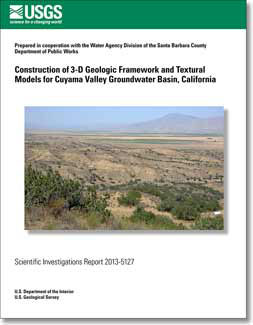 Abstract
Abstract
Groundwater is the sole source of water supply in Cuyama Valley, a rural agricultural area in Santa Barbara County, California, in the southeasternmost part of the Coast Ranges of California. Continued groundwater withdrawals and associated water-resource management concerns have prompted an evaluation of the hydrogeology and water availability for the Cuyama Valley groundwater basin by the U.S. Geological Survey, in cooperation with the Water Agency Division of the Santa Barbara County Department of Public Works. As a part of the overall groundwater evaluation, this report documents the construction of a digital three-dimensional geologic framework model of the groundwater basin suitable for use within a numerical hydrologic-flow model. The report also includes an analysis of the spatial variability of lithology and grain size, which forms the geologic basis for estimating aquifer hydraulic properties.
The geologic framework was constructed as a digital representation of the interpreted geometry and thickness of the principal stratigraphic units within the Cuyama Valley groundwater basin, which include younger alluvium, older alluvium, and the Morales Formation, and underlying consolidated bedrock. The framework model was constructed by creating gridded surfaces representing the altitude of the top of each stratigraphic unit from various input data, including lithologic and electric logs from oil and gas wells and water wells, cross sections, and geologic maps.
Sediment grain-size data were analyzed in both two and three dimensions to help define textural variations in the Cuyama Valley groundwater basin and identify areas with similar geologic materials that potentially have fairly uniform hydraulic properties. Sediment grain size was used to construct three-dimensional textural models that employed simple interpolation between drill holes and two-dimensional textural models for each stratigraphic unit that incorporated spatial structure of the textural data.
|
First posted July 11, 2013
Part or all of this report is presented in Portable Document Format (PDF); the latest version of Adobe Reader or similar software is required to view it. Download the latest version of Adobe Reader, free of charge. |